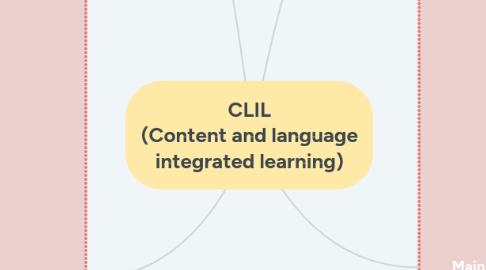
1. What is it?
1.1. Approach for learning and teaching languages
1.1.1. Language
1.1.1.1. English Spanish French Italian...
1.1.2. Content
1.1.2.1. Science Maths Social Studies Global Issues History...
2. Main terms
2.1. 4 Cs
2.1.1. Content
2.1.1.1. Curricular subject
2.1.2. Communication
2.1.2.1. Language skills
2.1.3. Cognition
2.1.3.1. Thinking processes
2.1.4. Culture
2.1.4.1. Cultural and intercultural knowledge and awareness
2.2. Kinds of CLIL
2.2.1. Soft
2.2.1.1. Lower accentuation of content and language
2.2.2. Hard
2.2.2.1. Strong emphasis of content and language
2.3. Bilingual brain
3. ELT VS. CLIL
3.1. ELT
3.1.1. Topics
3.1.1.1. To achieve language level objectives
3.1.2. Grammar
3.1.2.1. Learnt like patterns
3.2. CLIL
3.2.1. Topics
3.2.1.1. From real contexts
3.2.2. Grammar
3.2.2.1. Across usage
4. Other approaches
4.1. Communicative language CLT
4.1.1. Real contexts
4.1.2. Teacher: Guide and facilitator
4.1.3. Communicative goals
4.2. Task based language teaching TBLT
4.2.1. Language through tasks
4.2.2. Meaning and tasks completion have priority
4.3. Project based learning PBT
4.3.1. Final task
4.3.2. Content and language knowledge through projects
4.4. English for specific purposes ESP
4.4.1. Based on learners needs
4.4.2. Student as centre of learning process
4.5. Cognitive academic language learning approach CALLA
4.5.1. Incorporates students' learning strategies
4.5.2. Cognitive and metacognitive and socio-affective strategies
4.6. Content based instruction CBI
4.6.1. Based on a subject-matter core
4.6.2. Authentic documents
4.7. Sheltered instruction models
4.7.1. Comprehensible concepts
4.7.2. Promotes students' English language development
